a lion
Watch out, zebras are striped horses! Beware, fast antelopes! Beware, steep-horned wild buffalos!
The lion is out hunting!
It was as if thunder thundered and rolled through the bushes and thickets. This is a lion's roar, a lion's roar. And all the animals hid.
The lion is the strongest, the most terrible of all. His mane is thick, his claws are sharp, and his teeth are strong.
Who will he catch this night?
Bengal tiger
Among the animals of Asia there is also one of the largest tigers known today (second after the Far Eastern one). Its weight reaches 390 kg, with a length of up to 3.9 meters. The main way to attack the victim is from below. In this way he manages to successfully grab her by the throat in order to strangle her. Tigers can prey on both wild pigs and buffaloes weighing up to a ton.
Among all animals, tigers hold the record for the number of fatal attacks on humans.
Penguins
These are absolutely amazing birds - they are not like others. They fly in water, not through the air. They dive and flap their short wings so hard, they fly so fast under water that they catch up with the fish. And penguins also walk in a special way, in their own way: in columns. From a distance it seems that this man is walking in a black jacket and white vest.
One day a ship sailed into unknown cold lands. The sailors wanted to land on the shore - and suddenly they saw: a whole army lined up on the ice! We swam closer. And the army suddenly, as if on command, plunged headfirst into the water! It was only then that the sailors realized that these were not people, but birds.
Flora of Asia
Western Asia - South Caucasus and Western Asian Highlands
In this region of Asia, thanks to the moist soils of the plains and highlands, as well as steppe regions and deserts, a fairly complex endemism has formed, with more than 550 endemic plants, especially in the highlands and rocks. Relict forests give way to meadow areas where oaks and hornbeams grow, ash forests are found, and in dry areas feather grass and wormwood grasses grow. In the southern part of the Caucasus Mountains there are evergreen shrubs: laurel, holly, boxwood, and ivy vines and wild grapes intertwine arches between the branches of trees.
In the ecosystem of the Western Asian Highlands there are belts with relict broad-leaved forests and woodlands; thorny bushes grow on the rocks, which shed greenery in the dry summer season.
Northern Asia - Siberia and northeast Eurasia
The zone of Siberia and North-East Eurasia is quite diverse in terms of relief; here forest-swamp zones are located next to taiga, small-leaved, pine and birch forests, and tundra. In the extreme north-eastern part there are larch and cedar, lichens and deciduous forests with birches. The trees are mostly low, and the floodplains of rivers and lakes are surrounded by shrubby thickets of willow and alder. The taiga zone is almost completely covered with pine forests and fir forests; the ground resembles a carpet of green moss and rare flowers of wintergreen and northern linnaea. The river valleys are occupied by meadows with various herbs; anemones and asters, meadow fescue and foxtail are occasionally found.
Whale
The whale is the largest animal in the world. He lives in the sea, swims in the water like a fish.
A whale will swim into the cold seas, where there is only ice and snow, and it will also swim to the south, where it is hot all year round, chasing schools of fish. Where the fish go, there he goes.
A whale will capture a whole school of fish along with water in its mouth, release the water, but the fish will remain in its mouth - it will get stuck in the whalebone. Just don't think that this is really a mustache. There are these plates in the whale's mouth, like a lattice, and these lattice is called whalebone.
About the social relationships of baboons
They live and travel in large families. The family is headed by the strongest, most beautiful and experienced baboon. However, the aggressiveness of these animals forces the young to periodically challenge the leader’s right to leadership.
An interesting fact is the inequality in the female team of baboon families. The female that the leader prefers enjoys much greater authority and popularity among the rest of the pack, as do her cubs. But as soon as the main baboon shows attention to another female, all respect is lost.
Baboons feed mainly on plant foods, but they are absolutely omnivorous and do not disdain anything.
Elephant
A branch in the forest did not crunch, a leaf did not move - a huge wild elephant silently emerged from the dense thickets of the jungle.
The elephant stands like a towering gray mountain: legs like logs, ears like two sails, long tusks, crooked and strong. The elephant stretched out its trunk, tore a bush out of the ground, put it whole in its mouth and began to chew.
Such a strong man is not afraid of anyone, no one is afraid of him.
Fauna of Asia
Asia is home to a huge variety of living creatures that can only be found in this part of the planet. In addition to the most famous elephants, bears and Ussuri tigers, there are also very rare and unusual representatives of the fauna, such as the panda, peacock and sable.
The most famous predatory animals in Asia: Bengal tigers, crocodiles, bears, rhinoceroses, scorpions, etc. Cute pandas, orangutans, tapirs, as well as elephants and monitor lizards also live here. Later in the article we will describe in more detail some of the representatives of the animal world of this part of the world.
Hippopotamus
The hippopotamus can barely walk on its stumpy legs. The fat on it is shaking. If this fat glutton drags himself onto the field, he will devour the entire field, and what he has not eaten, he will crush. And then he goes into the river to sleep; dozes and basks on the water, like on the softest feather bed. Get some sleep, rest - and let's have fun. Here, in the water, he is not at all clumsy, but a very agile animal. It swims, dives, gets seaweed from the bottom, otherwise it opens its mouth - and it is huge, like an open suitcase - and screams, as if ten horses neighed at once.
Giraffes
Herbivorous giraffes are no less interesting.
- If humans have unique patterns on their fingers, and lions have unique muzzles, then giraffes have a unique recognition mark using the heel on their skin.
- Baby giraffes begin their lives with a difficult test: a fall from a two-meter height.
- The maximum time this long animal sleeps per day is one hour, and more often twenty minutes. Moreover, this dream occurs in a standing position, one can only be surprised at how they do not fall at this moment.
- The color of their tongue is black, and has an incredible length of 50 centimeters.
- There is no order in herds of giraffes, no matter what gender or age they are, everyone is equal and free access to it is open to everyone.
- Only the giraffe cannot yawn.
- They sleep little, but eat a lot, up to 20 hours a day. We can say that food makes up the main part of the life of these amazing animals.
Reindeer
In the North there is snow and ice, and the summer is short and short. You can’t make hay there, you can’t feed a cow or a horse in winter. Only reindeer can live there. He shovels the snow with his hooves and takes out a lichen - moss.
Whose milk do people drink in the North? Deer. What does he drive? On a deer.
Whose meat does he eat? Deer.
A person cannot live without deer in those places.
Orangutan
This is a large red orangutan monkey. In Malay, orangutan means forest person. The Malays tell a fairy tale about the orangutan. It was as if he had previously been a man and lived, like all people, in the village. Then he didn’t want to work and went into the forest to live in the trees. He grew all red hair and became a monkey.
Animals living in hot countries
The fauna of the hot regions of the world is diverse, and the animals there are beautiful, although the shapes and sizes of some do not seem the most attractive.
Different types of monkeys
Orangutans, chimpanzees, gorillas and other representatives of monkeys are a large group in which there are small individuals and huge, dangerous predatory animals with fangs several centimeters long. In their habits, behavior and some other aspects, these animals are very similar to people, and therefore often become objects of adoration.
Most monkeys have a long tail, which helps them climb trees. They also have long arms and legs with 5 fingers, with which they can cling to vines and branches and pick fruits.
Primates are an extremely intelligent species, distinguished by the ability to hide, wait, live in a pack, deftly get rid of predators and get food. The body of most monkeys is covered with hair, but without underfur, and there is no hair on part of the face.
The classic color is brown, brown, gray or black, as well as red, but there are also more exotic species. Mandrills, for example, have red and blue colored faces.
Lion is the king of the animals
A large wild cat that can break the back of a bull, antelope or other herbivore with one blow. Lions have the loudest roar; if you are close to them, you can easily go deaf for several minutes. Due to this, the cat received the proud title “King of Beasts”.
Lions live in packs called prides. In one group there is usually one male and several females, but there are prides in which 2-3 males dominate. Males have huge, beautiful manes, while females do not have them. The male has a tassel at the tip of his tail. The leaders of the pack, as a rule, do not go out hunting, leaving this right to the lionesses.
Elephants
The seemingly calm, intelligent and obedient animals are among the largest of those that live on land. The elephant is one of the few herbivores that can resist lions and tigers. The huge trunk serves as a “hand” for the elephant - it communicates with it, drinks water, and collects fruits and twigs from trees. Elephants have very thick skin that protects them from predators and the scorching sun.
Kangaroo
These animals live only in Australia and belong to the infraclass marsupials. Kangaroos grow taller than humans, but are born very tiny, after which they immediately move into their mother’s “pouch” and live there for several months. As soon as the cub turns one year old, it will leave the pouch.
Kangaroos have a very powerful tail and hind legs, allowing them to develop enormous speed and jump at distances of 7-10 m, or even more. These animals belong to the group of herbivores and feed mainly at night.
In Australia, the kangaroo population is protected, as at one time they were actively exterminated for meat.
Camels
Tall herbivores with 1 or 2 humps. They easily tolerate the drought of the hottest places on the planet - the Sahara and other deserts. They are distinguished by colossal endurance. They can easily survive for several weeks without food and a little less time without water.
Almost complete omnivory helps them survive - lichens, dry grass, cactus spines. A camel eats any food. And when danger appears, this animal is capable of unpleasantly spitting.
Zebras
Graceful representatives of the African continent have a short, protruding mane and a tail, like a donkey’s, with a small tassel. They are distinguished by their original striped colors. Moreover, the stripes are very clear. Adult zebras feed on tree bark, grass, and young twigs. Often groups of zebras graze together with giraffes, antelopes and even ostriches.
This “social” animal can fend for itself. If threatened, the zebra begins to bite and kick the enemy.
Giraffes
The tallest representative of terrestrial fauna, characterized by slowness. You can recognize them by their characteristic spotted color, head with horns and unusual physique. Giraffes also have extremely sharp hooves with which they can kill an enemy. They have excellent vision and hearing.
Indian porcupine
It has many long and sharp needles that it can throw at the enemy. When meeting an enemy, it “swells up”, raising its needles, and scares the potential victim. However, porcupines eat only plant foods.
Crocodile
A crocodile lies in warm water in the very sun, warming itself. He closed his toothy mouth and did not move his combed tail. It’s like it’s just a rotten snag lying in the water, and not a living animal.
A crocodile lies in the water near the shore, waiting for prey. When a zebra or antelope comes to the river to drink water, he will hit the animal with his strong tail, knock him off his feet, grab him with his toothy mouth and drag him into the water, to the bottom.
Lions
The kings of beasts contain a lot of interesting things, namely:
- Despite their courage and bravery, of all predators they have the smallest heart.
- they sleep 20 hours a day .
- The muzzle of these predators is unique; you cannot find two lions whose muzzle will be completely the same, although people do not always notice this.
- They may look like formidable creatures, but in the circle of their pride they behave very affectionately, they love to rub their faces against each other.
- Lions can begin to roar only after two years; before this time they simply do not know how to do it.
- Lionesses feed not only their cubs with their mother's milk, but also all others in the pride.
- Taking food from other predators is not the style of lions; they are disdainful of eating what jackals and hyenas have touched.
- They don’t hunt just for fun, so even zebras can sleep peacefully next to a hungry lion.
Walrus
The walrus is fat and heavy. Like a huge leather bag of fat.
Two huge white fangs protrude from his bristly mustache. Instead of legs, the walrus has flippers. He uses them, like oars, to rake water.
It will dive deep under the water and graze on the bottom of the sea, like a cow in a meadow. He chews algae, looks for shells, and when he has eaten enough, he swims up, leans on the edge of the ice floe or on the shore with his fangs, pulls himself up and crawls out of the water. He lies down on the stones and rests.
Zebras
So black with white stripes or white with black? An eternal mystery.
- Repeated studies have proven that the zebra is still black with white stripes.
- Despite their love of cleanliness and constant crawling out of each other, zebras do not deny themselves dirty dust baths.
- A zebra's mother's milk is not white, but soft pink.
- Zebras are team animals; they coexist in herds and stand guard while their relatives rest.
- In herds, everyone is divided into small families; family is generally the main distinguishing feature of these amazing animals.
- Since ancient times, people have tried to make zebras domestic, to tame them, but even today no one succeeds. Zebras love freedom, although their coexistence cannot be called absolutely free.
- Females carry their babies for a whole year before giving birth to them.
- Zebras can sometimes mix with ponies, horses and even donkeys. The resulting hydroid individual is called a zebroid.
Polar bear
The polar bear is a wandering animal. This tramp's fur coat is warm; the frost does not touch it. Thick fur does not get wet in water. He doesn’t care about frost, blizzard, wind, or icy water.
A polar bear walks and wanders on the ice and snow; catches prey - a fish or a walrus, eats his fill and immediately falls asleep, right there on the ice.
And when he gets enough sleep, he wanders off again. He looks out, sniffs out someone to catch, something to fill his belly with again. He dives deftly, runs quickly, and swims easily. Such a person will not remain hungry for long; he will get food for himself.
Rhinoceros
The branches in the forest crack, the trees sway and shake. This is a huge beast - a rhinoceros - bursting straight through the tropical thicket. He doesn’t care about thorns and thorns, hard branches and stumps. His skin is thick and strong, like armor: a spear will bounce off it, an arrow will break. Only a rifle bullet can pierce such skin.
The rhinoceros has a large horn on its nose, and its eyes are small and blind. He can't see well with them. He doesn’t really understand anything, but immediately rushes to butt heads.
A hot-tempered beast and suspicious.
About the external differences of baboons
These animals of hot countries also differ from other monkeys in appearance. They have a different head structure - the upper jaw bones are very wide and developed. The mouth of a baboon is also difficult to confuse with the mouth of monkeys of other species - this animal has protruding powerful fangs, giving it a resemblance to cartoon vampires.
But the most important external feature of the baboon, which is simply impossible not to pay attention to, is its bare buttocks. Moreover, their skin is brightly colored and, as a rule, in red shades.
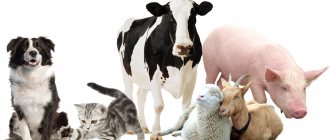
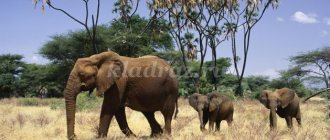
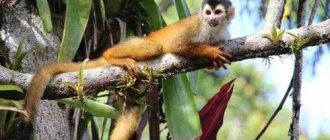
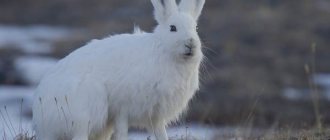
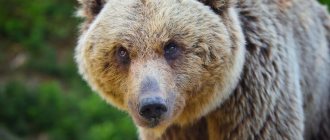

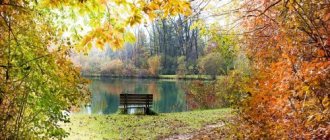

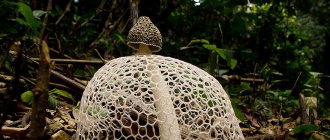

![Visual and didactic manual on sound automation [C] “Interesting cards”](https://pleshakof.ru/wp-content/uploads/naglyadno-didakticheskoe-posobie-po-avtomatizacii-zvuka-s-interesnye-kartochki-330x140.jpg)